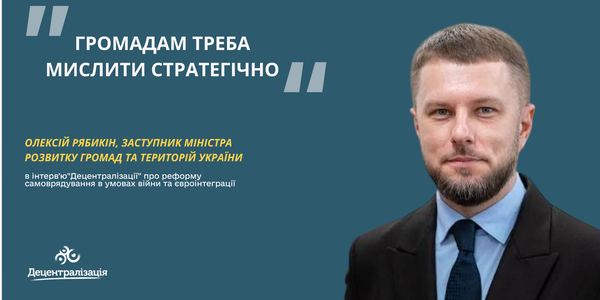‘Communities need to think strategically’: Oleksii Riabykin on local self-government reform in the context of war and European integration
Oleksii Riabykin has been working as Deputy Minister for Development of Communities and Territories of Ukraine for just under a year This is his first interview for the Decentralisation portal. The conversation focuses on the key challenges and tasks of local self-government reform, including how the context is changing under the influence of the war, the institutional decisions that communities need today, the cost to Ukraine of failing to vote for supervision, and what the law on powers will look like.
Full-scale war, mass displacement of populations, and preparation for EU membership – these are the defining features of the new framework for decentralisation. In this interview, Deputy Minister Oleksii Riabykin explains how the Ministry for Development is adapting the reform to meet current challenges, and emphasises the importance of strategic thinking at the community level for their development.
Mr Riabykin, could we start with the 2026 budget? The Government has already approved and submitted a draft law of Ukraine ‘On the State Budget of Ukraine for 2026’ to the Verkhovna Rada. What are your thoughts on what it provides for communities? To me, it seems like a step backwards in terms of financial decentralisation.
In fact, this draft law poses a serious challenge. It will affect communities and our Ministry alike. Earlier, it was widely announced that approximately UAH 30 billion would be allocated to the State Regional Development Fund (SRDF). However, the draft budget now only includes UAH 2 billion.
By way of comparison, a commission has already begun work this year to make a final decision on the distribution of SRDF funding.
In recent years – 2022, 2023 and 2024 – the SRDF had virtually no funding. This year, funding has been restored, albeit only in the amount of UAH 1 billion. Meanwhile, communities have submitted applications totalling UAH 6.5 billion.
In other words, a fairly consistent practice has already been established: the volume of project financing requests within the framework of the SFRD or the Ukraine Recovery Programme exceeds available resources by 4–6 times. These are not fantasies or whims of communities; these are real projects with up-to-date technical and cost documentation, often prepared with community funds or with the support of international partners.
Therefore, today we are faced with a serious challenge: how to ensure a balance between the expectations of communities and the real capabilities of the state.

Oleksii Riabykin, Deputy Minister for Development of Communities and Territories of Ukraine
What is the Ministry’s view on the 4 per cent reduction in personal income tax?
It is negative. Without a doubt. There are already enough topics causing debate, and this is definitely not one worth spending time and resources on right now.
However, I am in favour of finally establishing a clear delineation of powers between the executive bodies and local governments. It is important that we understand where powers belong to the state, where they belong to communities, and where there is a ‘grey area’ that cannot easily be attributed to either.
Every power and service provided by the state or community must incur a corresponding cost. Only when we clearly understand these costs can we reasonably discuss any form of compensation, whether it be 60 per cent, 60 per cent plus 4 per cent, or other mechanisms provided by the state.
It is also important to know whether the community has sufficient funds from its own sources, such as local taxes and fees, to exercise its powers.
This should form the basis for assessing the capacity of communities, in terms of their financial and institutional capability to perform their tasks, and their need for additional funding to address disparities in development.
All of this is interconnected. Until we answer these fundamental questions, it is a waste of time to return to the discussion of reducing personal income tax, because the outcome is predictable in advance.
So when will the draft framework law on the delineation of powers be ready?
It is almost ready. The draft law on the delineation of powers consists of two parts. The first part defines the principles, criteria, and foundations for the delineation of powers. This establishes clear rules for all parties to follow. The second part concerns the sectoral delineation of powers, meaning the specific delineation of functions between the state and communities in various areas.
The working group agreed that discussions on sectoral differentiation would occur, which is normal. The strategy is therefore as follows: first, a framework law will be registered that sets out general principles; then, the details of sectoral delineation will be formalised in a subsequent draft law.
The most important thing is that the discussion is constructive, not destructive. After all, the ultimate goal is to establish a consensus that will form the basis for further local self-government reform and subsequent steps in decentralisation.
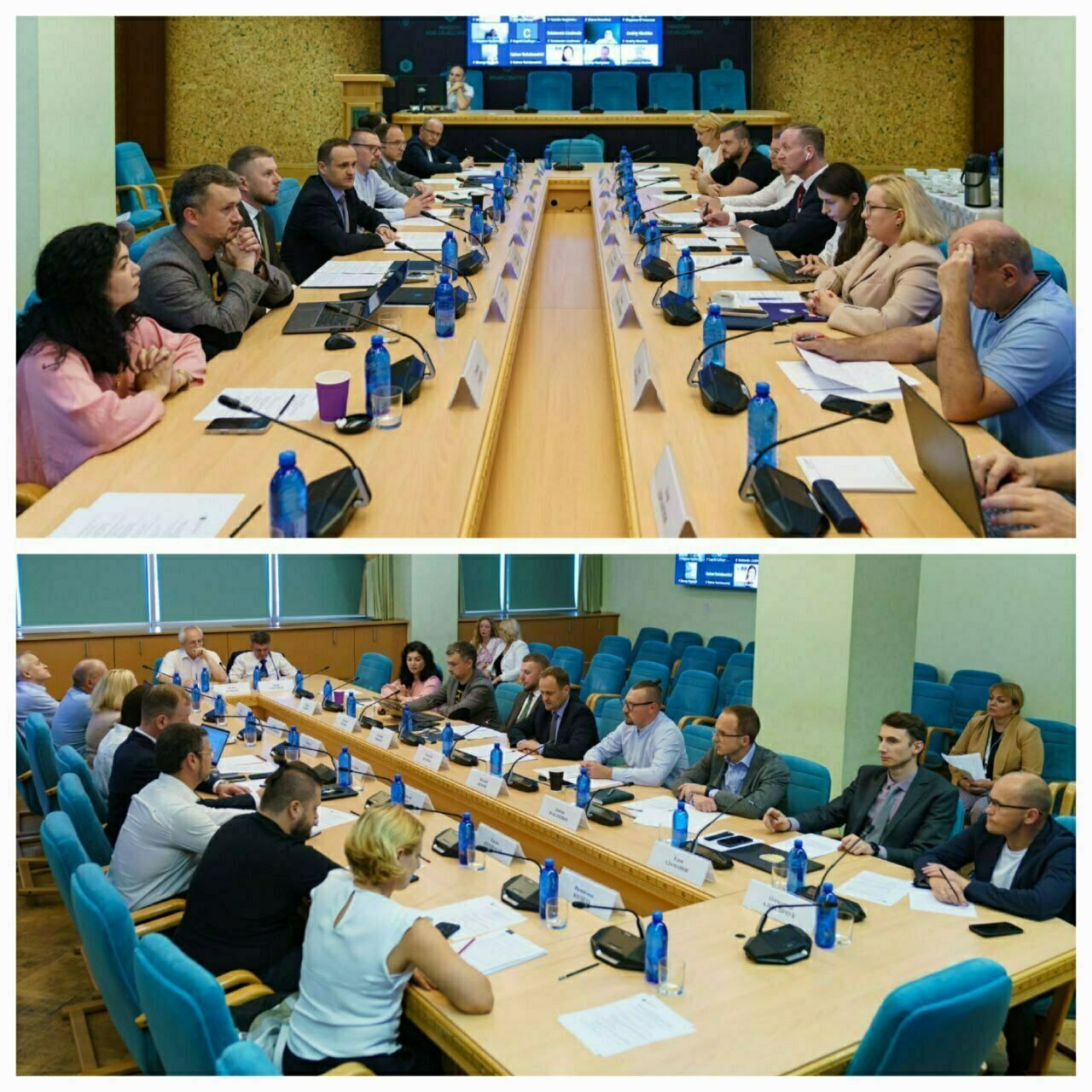 Meeting of the working group on the delineation of powers between local governments and executive authorities based on the principle of subsidiarity, September 2025
Meeting of the working group on the delineation of powers between local governments and executive authorities based on the principle of subsidiarity, September 2025
What stage is the draft law currently at?
We plan to ask MPs to register the draft law next week. Meanwhile, the working group will be finalising the first part of the document. I am confident that this step will be taken in the near future.
This is an important point for both legal and financial reasons.
A clear delineation of powers is essential for reviewing the financial basis of these powers.
After all, when we consider where personal income tax should be paid, the question arises as to whether it should be calculated based on the place of registration of the legal entity or the individual taxpayer. This is not a minor issue.
Imagine a community in the historic centre of an agglomeration. The legal entity is registered there, but employees commute from the outskirts, using the local infrastructure. While the centre of the agglomeration benefits from taxes, the periphery effectively loses out on its fair share of funding that could be used to develop infrastructure and services for its residents.
That is why the draft law and this delineation of powers are a vital step. It will enable an assessment of the real needs of communities in terms of resources to fulfil all their responsibilities, while also providing an understanding of the financial mechanisms that need to be applied: both from local taxes and fees, and from the portion of national taxes distributed at the local level. This provides the basis for communities to plan their development realistically and for the state to support them effectively and transparently.
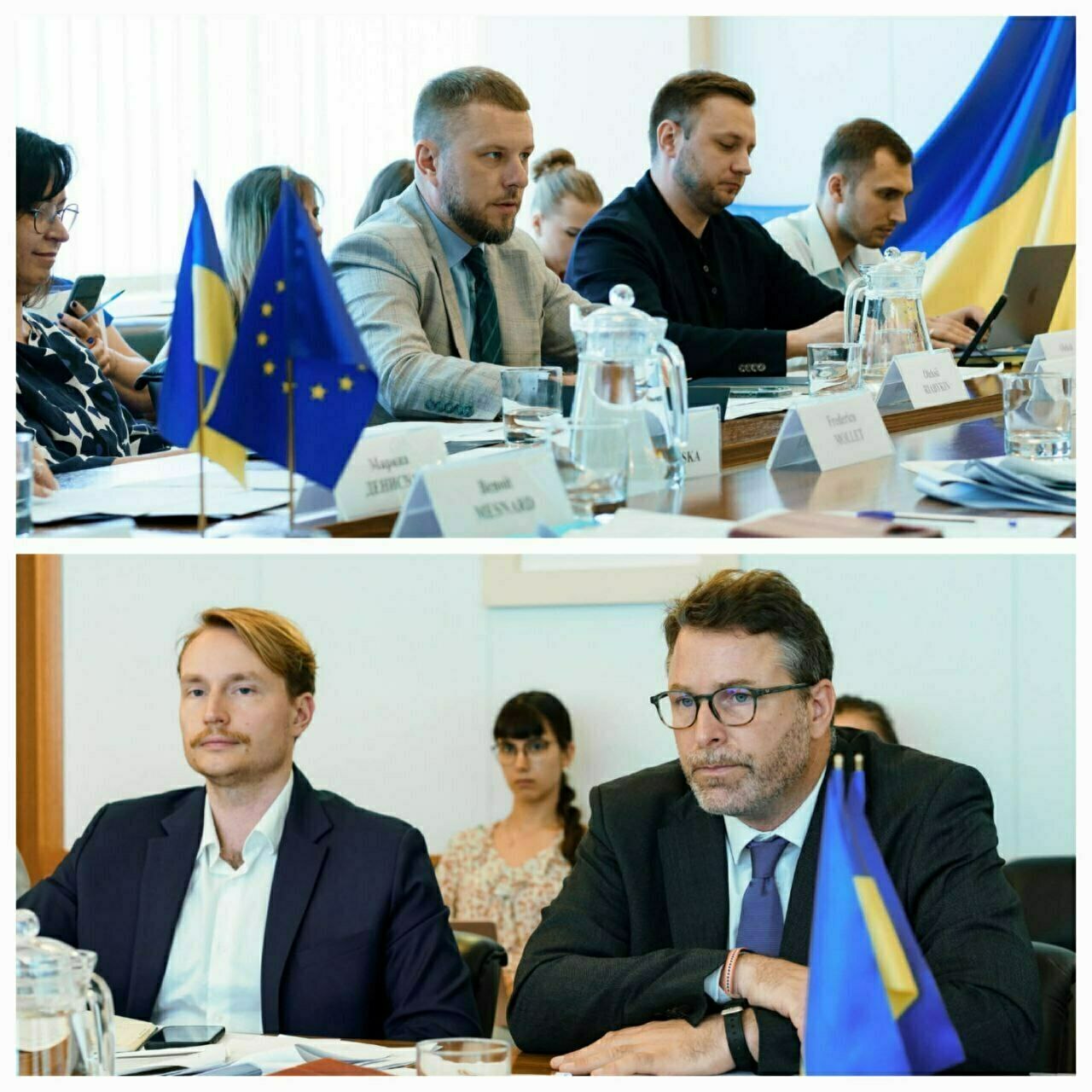 Meeting with the delegation of the EC Directorate-General for Enlargement and the Eastern Neighbourhood, July 2025
Meeting with the delegation of the EC Directorate-General for Enlargement and the Eastern Neighbourhood, July 2025
Many communities say they are ready to independently administer local taxes and fees. Some estimate that they could increase their budgets by several million if they were given this opportunity. So why not legislate to give capable communities the right to administer local taxes and fees? Last year, the Ministry of Finance developed a draft law to enable this, but it was never adopted.
Indeed, this draft law has been developed – it amends the Tax Code. The issue has been discussed repeatedly, even at meetings of the Cabinet of Ministers when Denys Shmyhal was Prime Minister. At that time, the general attitude was very positive, with both the State Tax Service and the Ministry of Finance supporting the idea of transferring relevant powers to capable communities.
We also support this approach. However, we believe that,
before delegating tax administration, communities should take an inventory of their land plots and real estate properties.
This enables the tax base to be expanded and revenues to local budgets to be increased. Unfortunately, not all communities have a complete database of real estate assets, and not all of them receive 100 per cent of the property tax. Some cultivated agricultural land does not generate tax revenues.
In other words, administration is just one aspect of the issue. The second part concerns the most effective use of the existing tax base, which communities could achieve even without additional powers. We can see that communities that are willing and ready to work achieve results. This is normal and correct practice, a European approach.
This is not just a matter of principle – it is about real money. According to rough estimates, the shortfall in local taxes from these areas amounts to around UAH 30 billion. These funds could be used to improve municipal infrastructure and services for people in communities.
I therefore urge all communities to seize control of this issue, take an inventory of their property, and make the most effective use of the resources that already belong to them by law.
To conclude the discussion on finance, I would like to ask about the draft law on administrative fees, which has not been adopted by the Parliament for many years. It was approved in the first reading not long ago. This law would enable communities to generate more income from the services they provide through the Administrative Service Centres, allowing them to provide high-quality, accessible services. The delay in passing this law is obvious and seems deliberate. Who benefits from this?
While I cannot say for certain who is responsible for the delay, I would like to emphasise the scale of the consequences. Recently, just one day of voting in the Verkhovna Rada cost our country EUR 710 million.
Do you mean Draft Law No. 13150?
Exactly.
This is a very difficult and painful topic for me personally. Not only did we as the state fail to meet the indicators, meaning we did not receive the funds provided for in the Programme, but we also appear inconsistent to our international partners.
Why was the draft law not adopted? Who made it fail?
Reforms always go through critical and difficult moments. The draft law was perfectly ready for adoption: it met indicator 9.1 and was supported by the European Commission and three out of four local government associations.
I find it hard to explain why the MPs made a different decision. But, as the Ukrainian classic says, ‘We have what we have.’ The main thing now is to maintain focus and continue working to ensure that such initiatives are successfully implemented in future.
What are the next steps for the draft law that was intended to introduce the supervision of local government decisions for their legality?
MP Vitalii Bezgin has currently registered a new Draft Law No. 14048. From what I have seen, the draft law provides for supervision without creating a register of local government acts, and it defines the procedure and levels of supervision.
It appears that the document also concerns the personnel reserve and the establishment of a civil service for heads of district state administrations, which will act as one of the levels of supervision. The Ministry will certainly provide its analysis.
In my opinion, ‘proportionality’ is the best word to describe this.
Supervision should be both proportional and effective. It should not put pressure on communities; rather, it should protect them from unlawful decisions. It is primarily a preventive tool: by consulting and communicating with state supervisory bodies, we can prevent violations before they become a problem.
Another important role of supervision is to protect communities and their officials from management decisions becoming the subject of law enforcement scrutiny. Often, it is precisely the lack of clear procedures that leads to conflict situations. Having a clearly defined state supervisory body and transparent procedures is a safeguard against unnecessary problems and manipulation.
Draft Law No. 13150 stipulated that supervision would commence 12 months after the legal regime of martial law ended, initially at the regional state administration level and subsequently at the district level. This is logical in terms of delineating and distributing powers: local state administrations retain their supervisory function while administering European structural funds, which require competent management at regional level.
In Poland, for example, European funds are administered at the voivodeship level, while the Ministry of Regional Development supervises overall policy. This could serve as an example of an effective model of supervision and administration for us.
At the same time, it is claimed that 26 different supervisory bodies are already ‘putting pressure’ on local governments. Is this true, or is it a form of manipulation?
I would rather leave this question to those who make such claims. Unfortunately, we live in a world today where information leaks and manipulation spread easily, whether consciously or unconsciously.
What I can say for certain is that there are law enforcement agencies, judicial authorities and executive bodies with certain powers, which is sufficient for regulation. All the other ‘26 bodies’ seem like a myth often used in discussions about the risks of introducing supervision. Personally, I am surprised by such statements because, in practice, introducing proportional supervision only reduces risk and creates a transparent control system, rather than causing chaos.
There are concerns that introducing supervision of local government decisions could lead to ‘manual control’ by state administrations, pressure, or interference in the work of communities. How can such risks be prevented by law?
This can actually be solved quite simply – by completely digitising processes.
When every act of a local government is entered into a digital register with open access for citizens, experts, international partners and journalists, it effectively prevents any ‘manual’ interference. This makes it difficult to manipulate or distort information, or to question the legitimacy of an act.
However, transparency is a two-way process. Both state bodies and communities must be willing to be transparent. State executive authorities must act within their powers and avoid manipulation, while local governments must be as open as possible to citizens. The public must be able to see all decisions, understand their rationale, and influence the process.
Digitalisation helps to strike a balance: communities perform their duties transparently and state supervision becomes a genuine safeguard rather than a means of exerting pressure. This fosters trust, effective collaboration and genuine partnership between local authorities and the executive branch of government for the benefit of the people they serve.
The Ministry for Development is currently conducting regional consultations on a document entitled ‘Specifics of Implementing the Concept of Reforming Local Self-Government and Territorial Organisation of Power in the Context of Military Challenges and Preparing for Ukraine’s Accession to the European Union’. Could you please expand on this, explaining what the document is, why it was created, what its purpose is and what its main essence is?
This document should be considered in the context of the 2014 Concept of Reforming Local Self-Government and Territorial Organisation of Power. At that time, it became a kind of ‘worldview’ document that catalysed the development of a comprehensive set of normative acts and ensured the implementation of one of Ukraine’s most successful reforms – decentralisation.
However, the situation changed dramatically after Russia’s full-scale invasion. We now face new challenges, including the mass displacement of the population, the destruction of various types of infrastructure, and large-scale environmental disasters such as the Kakhovka dam and hydroelectric power plant disaster. A prompt and systematic response from the state is required to address these challenges.
That is why a new document has been drafted, which we are discussing at regional consultations. It does not change the basic concept of 2014 and does not deviate from the priority of decentralisation, but rather details the specifics of its implementation in new conditions, in particular, first, in the conditions of the legal regime of martial law; second, in the conditions of Ukraine’s accelerated European integration track and preparation for EU membership.
The document outlines how state and local authorities should act to respond effectively to the challenges of war, maintain governance standards, and ensure the implementation of delegated powers.
The main idea is that
the Concept, as a strategic document, remains unchanged. The new document, meanwhile, establishes the ‘rules of the game’ for its implementation in specific crisis conditions. It ensures that reforms can be adapted to current challenges without compromising the integrity of the reform course.
What comments or suggestions have communities already provided during the first consultations on this draft document?
The comments and suggestions from the communities are very diverse and mostly concern practical, rather than conceptual, aspects. These details will be taken into account in the next stages of preparing the regulatory documents for implementing the Concept.
We also held extensive discussions at the international level – in Strasbourg, with the participation of the Congress of Local and Regional Authorities of the Council of Europe, associations of local governments, MPs, and central executive authorities. The documents developed there were supported by experts and associations, with around 90 per cent of the proposals being taken into account.
During regional consultations, we have heard more about the specific, practical steps that communities consider necessary for implementing reforms in their work. These proposals will form the basis of further regulatory documents, which will regulate the implementation of the basic Concept and the specifics of its implementation in the context of war and preparation for European integration.
In other words, the first stage of consultations provided valuable insights into how reform theory correlates with the reality on the ground and what we should focus on next to ensure the effective implementation of reforms.
During regional consultations, one of the local government associations proposed its own ‘Concept for Recovery of Local Self-Government’ while also advocating the preparation of a new concept for reforming local self-government and territorial organisation of power. What is the position of the Ministry for Development?
I believe that local self-government in Ukraine has already proven itself capable and effective. It has defended the state since the beginning of the war. While its role is different to that of the Armed Forces, local governments have made a significant contribution to repelling armed aggression.
This is evidenced by the fact that many Ukrainian cities have been awarded the title of ‘hero city’ – and this is no coincidence.
They received hero city status precisely because community leaders and residents stood up to defend their homes, villages, settlements, and cities. Therefore, I firmly believe that there is no need to ‘restore’ local self-government in the full sense of the word – it is fully capable of performing its functions.
At the same time, there have been exceptional cases where military administrations have had to be set up due to war or collaboration with the enemy. For instance, in Hostomel, the village head was killed and the local council was rendered incapable of action, forcing the state to respond by establishing a military administration. Similar cases can be found not only in the Kyiv region, but throughout Ukraine.
While there have been cases of mayors collaborating with the enemy, there have also been heroic examples of mayors who have defended their communities at the cost of their own lives or freedom. A recent example is the former mayor of Kherson, who was recently released. In my opinion, this clearly demonstrates the capacity of local self-government.
During the fourth year of full-scale war, it is crucial that local governments continue to perform their functions, respond to wartime challenges, and support the civilian population and Armed Forces of Ukraine. This is serious, large-scale work.
Regarding the initiatives of the association: I asked the representatives directly if they were insisting on their concept of restoring local self-government. They replied that they did not. This was also confirmed during meetings with international partners and other associations. At the same time, they submitted their proposals for the ‘Specifics of Implementing the Concept...’, 90 per cent of which were taken into account.
What will the first practical step be after the Government approves the ‘Specifics of Implementing the Concept...’?
The first practical step will be to work on the Implementation Plan. This will provide a clear roadmap, determining which specific documents need to be developed and adopted to launch the implementation of the specifics and the Concept itself. In other words, we are transitioning from a general strategic framework to the development of specific tools to ensure the effective implementation of reforms.
 Regional consultations on the Draft Document ‘Specifics of Implementing the Concept of Reforming Local Self-Government and Territorial Organisation of Power in the Context of Military Challenges and Preparing for Ukraine’s Accession to the European Union’, Poltava, September 2025
Regional consultations on the Draft Document ‘Specifics of Implementing the Concept of Reforming Local Self-Government and Territorial Organisation of Power in the Context of Military Challenges and Preparing for Ukraine’s Accession to the European Union’, Poltava, September 2025
Are there plans to review the criteria used to assess community capacity, and if so, which aspects will be reconsidered? These criteria may include not only population size and budgetary self-sufficiency, but also institutional, administrative, and financial capacity, as well as the ability of communities to respond effectively to contemporary challenges.
This is a sensitive issue, and it has already been subject to a great deal of manipulation. For example, there are rumours that the Ministry for Development will change the boundaries of communities.
Currently, the Ministry is not developing any projects that would change community boundaries – whether enlargement or reversal processes. Communities will remain within their existing boundaries.
At the same time, we recognise that communities have not yet had the opportunity to demonstrate their full capabilities since their formation. After all, the last few years have been challenging, with first the COVID-19 pandemic and then full-scale war.
At the same time, we have developed criteria for assessing community capacity. These criteria serve as a tool not only for the state to support communities, but also for the communities themselves. They enable communities to understand where their strengths lie and where imbalances exist, whether they be institutional, administrative, financial or related to infrastructure development. We plan to launch monitoring of this process in the near future.
The methodology for establishing capable communities must be updated with new criteria and requirements to enable a more objective and accurate evaluation of capacity. Reconsideration will only be possible once communities are able to realise their potential under the new criteria,
This issue will definitely not be addressed in the coming years. Currently, the approach is as follows: first, we assess capabilities in real conditions, support communities, and only then – if data and appropriate circumstances are available – we can consider any structural changes.
How would you evaluate the role of district councils within the current system of local self-government, considering that the majority of powers and resources have now been transferred to the community level? What tasks can district councils perform effectively?
Since we began rethinking strategic planning for regional development in November 2024, it has become clear that the regions have virtually no coordination of strategic priorities among themselves. The development strategies of neighbouring regions are not aligned, and there are no shared objectives or performance indicators.
For me, this is both a discovery and a challenge. How can we discuss the harmonious development of regions and macro-regions when they are moving independently of each other? This is an area in which district councils could play a key role. The law stipulates that they represent the interests of all residents of the relevant administrative-territorial unit. They can therefore coordinate the activities of communities, agree on strategic directions, stimulate inter-municipal cooperation, and pool resources for joint projects.
The role of the district council is invaluable: it can balance competing interests and help communities implement joint initiatives to achieve better results. The discrepancies between regions and communities that we observed in November 2024 highlight the need for such a coordination mechanism. There is no need to discuss implementation in each community separately; having such a tool for several communities is sufficient. This would solve the problem and optimise resources. It is enough to create an effective mechanism for several communities in the region that would work for everyone.
Why is this not happening now?
I think district councils are in the process of developing a new identity and defining their role in the modern system.
At the same time, many professionals are working there who could actively engage in this process. The Ministry is ready to support districts and regions in rethinking the role of district councils, as well as providing them with the administrative and institutional capacity to perform this coordination function effectively.
Since we have started discussing state regional policy, if I recall correctly, the State Strategy for Regional Development was updated in August 2024. Has the plan for its implementation already been approved?
We are currently awaiting approval of the implementation plan from the central executive authorities. We hope it will be submitted to the Cabinet of Ministers for final approval next week.
Implementing this Strategy is part of Ukraine’s European integration process, as well as fulfilling its relevant commitments.
What progress has been made in updating regional and community strategies in line with the new National Strategy?
To date, 22 regional strategies have been approved. Regarding communities, over 1,300 are engaged in strategic planning, with some having already approved their strategies and others in the final stages of development and approval.
This is an important step in the reform of public investment management. From now on, having a strategic plan will be a prerequisite for obtaining and using public funds effectively at local, regional, and national levels.
Communities are currently developing medium-term plans for priority public investments and forming unified project portfolios. The Ministry for Development of Communities and Territories, the DREAM team, the Ministry of Finance and the Ministry of Economy are assisting them in this process and acting as key coordinators.
To improve the quality of strategic planning, we deliver training programmes to communities and regions in person and online. These programmes enable communities to structure their plans correctly, use resources effectively and make public investment management more transparent.
For medium-term community development planning, several documents need to be developed: a community development strategy, an integrated development concept, a territory restoration plan, and a comprehensive restoration programme. Why do communities need so many documents?
To be honest, I do not quite understand why there need to be so many. In my opinion, one or two documents would be sufficient for planning at community and regional levels.
If we really want to help communities, we need to ensure that there is only one main document.
There is the Verkhovna Rada, and issues are regulated by law. We already have draft laws that provide for a significant reduction in the number of strategic planning documents. Furthermore, we explicitly emphasise in our communications that
the main focus should now be on community and regional strategies. For now, all other documents can remain ‘on the shelves’ – they are not urgently needed for daily work and planning.
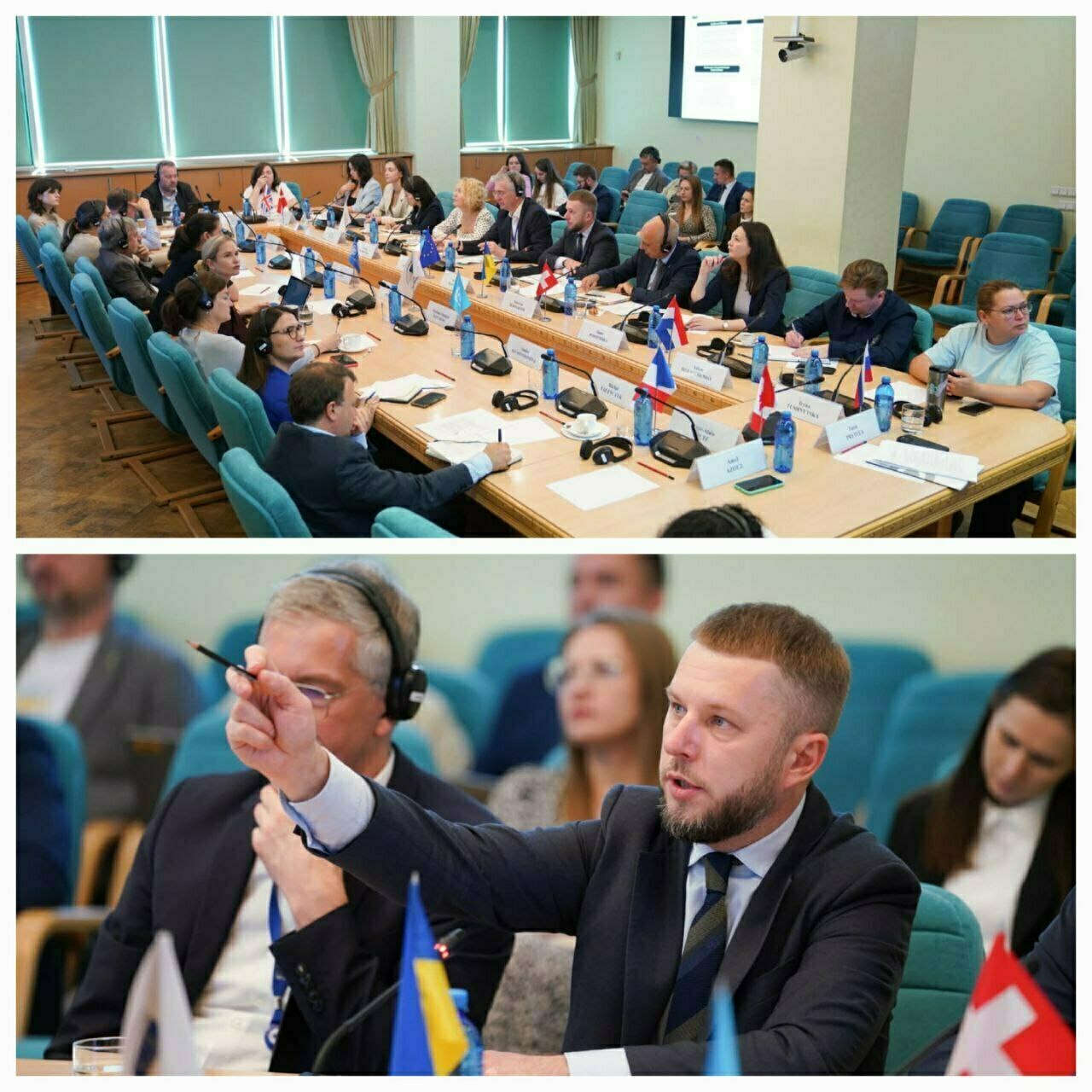 Meeting of the Sectoral Working Group on Decentralisation and Regional Recovery, July 2025
Meeting of the Sectoral Working Group on Decentralisation and Regional Recovery, July 2025
The Ukraine Facility Regulation provides for the allocation of over EUR 1 billion in non-repayable funds to Ukraine for the restoration, reconstruction and modernisation of territories – transport, energy, human capital development. The effective use of such funds requires capacity of local and regional authorities. Has the Ministry considered allocating part of these resources to strengthening the capacity of these authorities, so they can work effectively with these funds and, in future, with resources in line with EU cohesion policy?
Let us break this question down a bit. If we are talking about European structural funds, Ukraine will gain full access to them upon joining the EU. However, we need to start developing a national model for attracting such funds now. In particular, we are focusing on the Polish model, as it is similar to ours in terms of administrative structure and population size. However, our system will have its own characteristics.
We have the Interreg programme, in which communities are already participating actively. It is important to understand that these funds do not advance projects; rather, they compensate for the costs of implemented initiatives. The original idea was that the State Fund for Regional Development, which is expected to receive approximately UAH 30 billion next year, would fund the implementation of projects in communities, with the Ukraine Facility compensating these funds. This would create a success story for both the state and the community, strengthening the institutional capacity of local authorities.
It is important for us to mobilise these resources at community and regional levels. This work is currently underway with our national partners. The problem is that the implementation indicators for the Ukrainian plan are not always met on time. For example, the last tranche resulted in the state receiving almost EUR 1.5 billion less than expected. Therefore, we need to actively address this issue.
With regard to the preparation of the regional policy management system and the use of EU funds, we envisage three levels: national administrator – preferably a Ministry; regional administrator – ideally a regional state administration; recipient of funds – the community.
We are currently preparing a screening of Chapter 22, which includes ‘Regional policy and coordination of structural instruments’, and have already received recommendations on how to organise the process to ensure we are ready to implement a European-style cohesion policy. No specific model has yet been implemented in Ukraine, as the process requires time and approval from the European Commission.
Turning to screenings, are local government associations or communities themselves involved in analysing legislation in a particular area? I recall that some countries only recognised the importance of such involvement after several years of preparing for EU membership.
Yes, we involve all interested parties, including representatives from communities, local government associations and civil society institutions. To date, we have held a series of such events to discuss key issues in detail.
The screening comprises 22 questions and over nine presentations. It addresses various aspects of regional policy, which differs slightly from European policy. Specific screening questions cover topics such as the administrative capacity of municipalities and other levels of government, the implementation of EU cohesion and anti-corruption policies, and the monitoring and auditing of the use of European funds. The use of digital tools, communication, transparency, and the relevant legislation governing these processes are also considered.
This is a complex task involving virtually all ministries and a large number of stakeholders. I am very grateful to the team for their preparation of this process, and I hope that we will receive positive assessments from the European Commission and other relevant experts.
Ultimately, screening provides an opportunity to develop an action plan for aligning national legislation with European approaches and models. This is essential for preparing Ukraine for the implementation of EU cohesion policy.
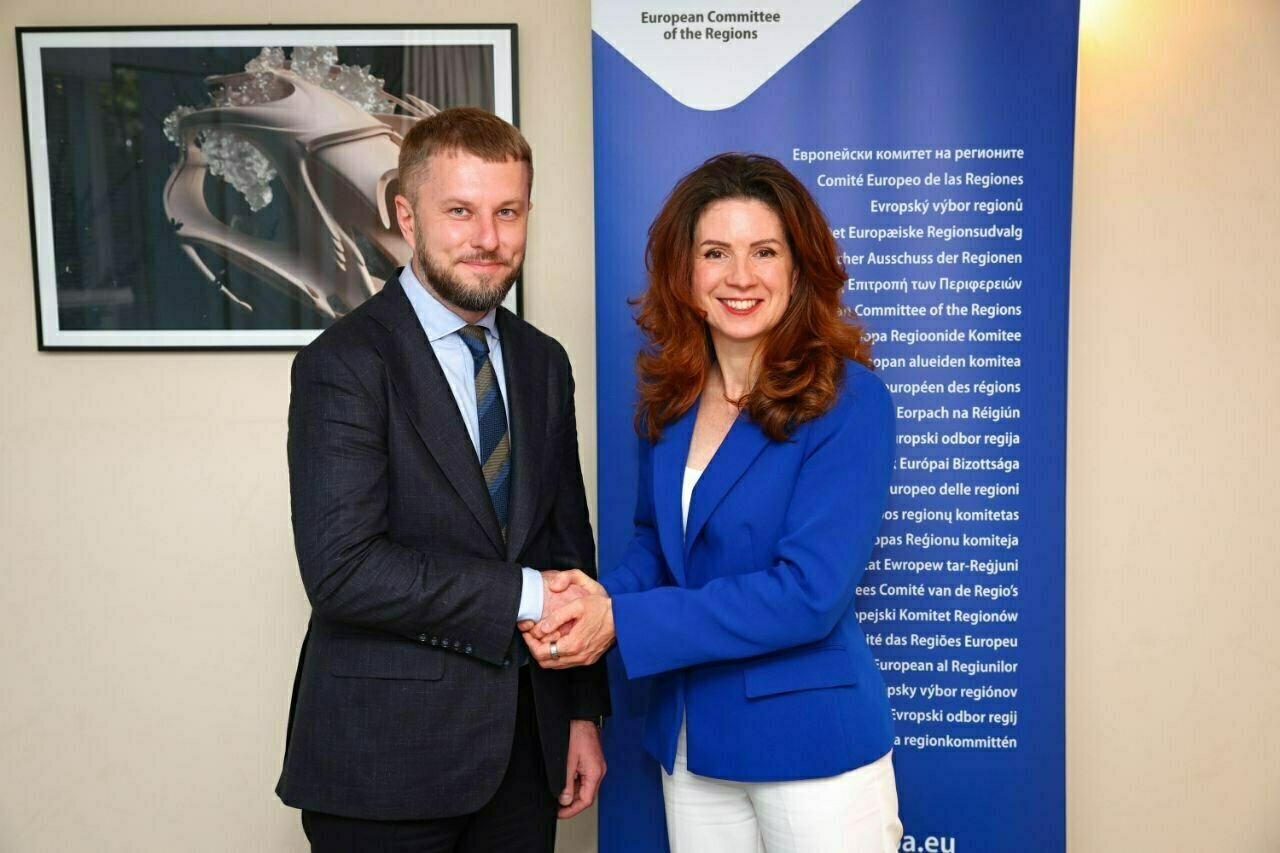
Oleksii Riabykin, Deputy Minister for Development of Communities and Territories of Ukraine, and Kata Tüttő, President of the European Committee of the Regions
Is work currently underway to define the functional types of territories? Specifically, in accordance with the law and the recommendations of the European Commission?
This work is ongoing. It is necessary to define functional types of territories in order to implement a territory-oriented approach to the use of funds.
The Government is responsible for making decisions regarding support for frontline communities. Frontline territories require special attention as significant reconstruction work is being carried out there. In fact, these territories are one of the functional types of territories. To regulate these processes legislatively, we must first clearly define these functional types.
At the same time, we are digitising this information. All of these territories are entered into the regional development geoinformation system implemented by the Ministry. This means that, alongside the quality assessment of DREAM projects, we can also evaluate the needs of each territory and its compliance with specific management decisions.
Oleksii, you joined the Ministry’s team at a time when USAID was concluding its operation in Ukraine. What effect did this have on communities and the work of the Ministry?
This is true, USAID ended its participation in the programme to support decentralisation, but this has not stopped our work. We are continuing to work actively and have strong support from many international partners.
We currently have productive cooperation with ULEAD, GIZ, ALINEA, UCORD, DECIDE, EGAP, POLARIS, OECD, the Council of Europe project ‘Strengthening Multilevel Governance and Local Democracy to Support Ukraine’s Recovery’, the Congress of Local and Regional Authorities of the Council of Europe, the United Nations Development Programme, and many partner countries, including Canada, Germany, Switzerland, Sweden, France, Japan, Slovenia, Poland, and other EU countries.
During my time in the office, we held two Sectoral Working Group meetings, which were attended by representatives from all of these organisations and partner countries. At these meetings, we identified clear priorities and work plans, and we are consistently moving forward with the planned agenda.
What would you like to tell communities right now to reassure them that the Ministry for Development of Communities and Territories is working closely with them?
First and foremost, it is our daily actions and joint efforts that best demonstrate our common vision with the communities. However, I would like to emphasise the importance of communities being active and thinking strategically.
As an example, I am currently analysing the medium-term public investment plans that have been registered by communities on the DREAM ecosystem. Their priorities are most often education, healthcare, and municipal infrastructure. While this is understandable, there is a lack of ideas that could unite the community and be supported by the infrastructure.
The idea sparks development. Look at the examples: Bukovel – thanks to a clear tourism development plan, the entire infrastructure was upgraded, including roads, healthcare and social services; Bilbao (ed.: a city in Spain famous for the Guggenheim Museum. One cultural project transformed a declining industrial city into a tourist and economically active centre, showing how an idea can drive development) – one world-class museum launched a whole wave of investment and modernisation of the city's infrastructure.
Communities should consider how to attract investors, create jobs and increase their tax revenue. This is achievable even in challenging times when the state is focused on war and is partially funded by donors. Communities have their own taxpayer resources and freedom of choice – they should make the most of this.
There is no better time to act than now. This demonstrates the resilience, opportunity, and heroism of communities. Every contribution to development and every decision that supports people is our shared victory. We have already won because we did not give up; we continue to live, work, and develop.
The goal of the Ministry is to help communities transform resources and ideas into tangible results by implementing European practices, improving services and meeting people’s needs. While administrative, medical, social, educational and municipal services form the foundation, it is the unifying idea that brings together resources and efforts to create real development.
Even in these challenging times, it is crucial for communities to think strategically, generate ideas, and optimise their resources. This is the key to both their self-sufficiency and our shared victory.
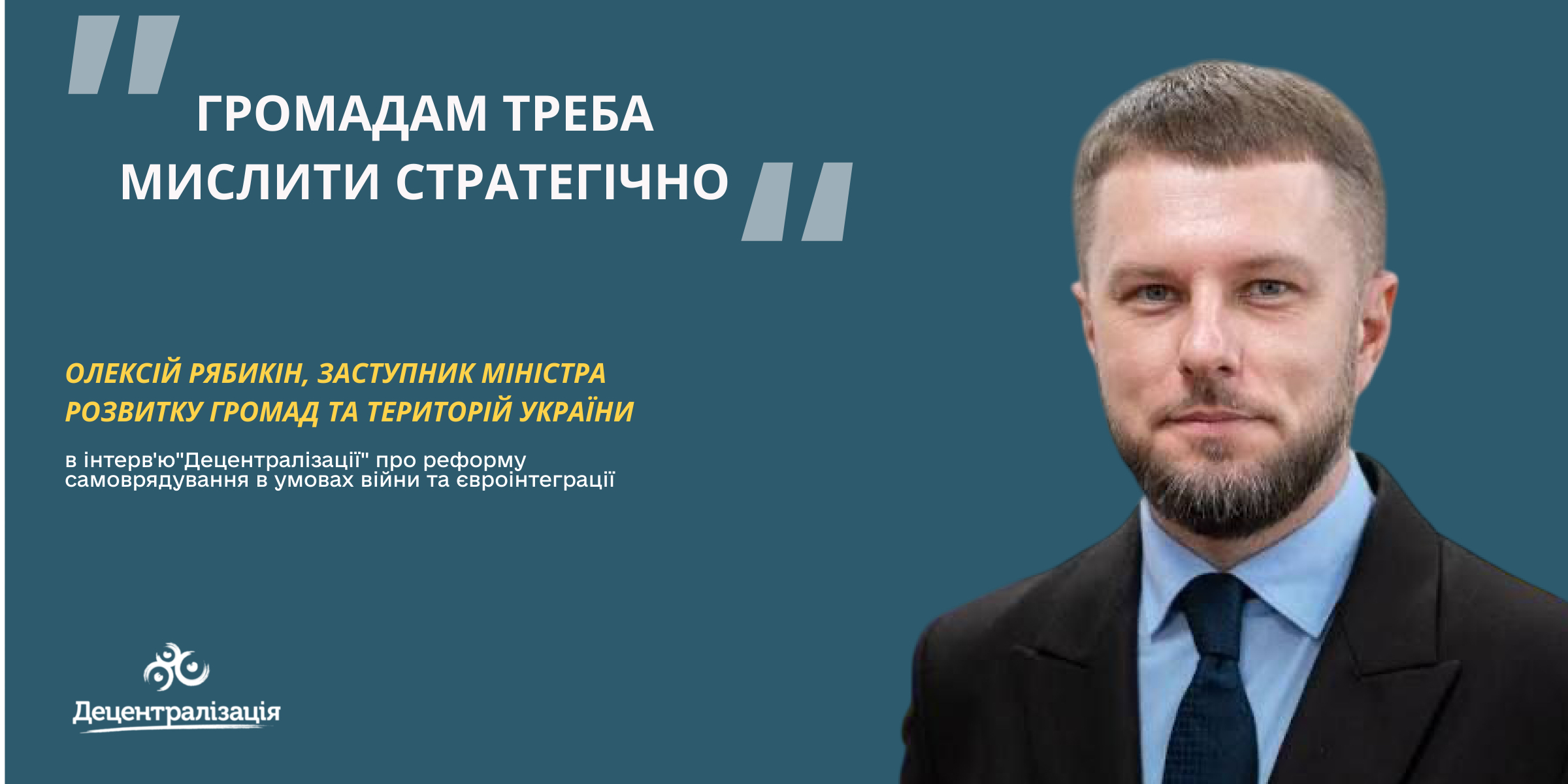
10 October 2025
Як громадам уникати корупційних і управлінських ризиків у публічних інвестпроєктах
Як громадам уникати корупційних і управлінських...
Публічні інвестиційні проєкти – це потужний інструмент розвитку громад. Саме завдяки таким проєктам їм у...
10 October 2025
Вебінар про реалізацію субвенції НУШ у межах Ukraine Facility
Вебінар про реалізацію субвенції НУШ у межах...
16 жовтня 2025 року о 14:00 відбудеться вебінар «Особливості реалізації субвенції НУШ в межах Ukraine...
10 October 2025
Ukraine to be represented at EURegionsWeek 2025 in Brussels
Ukraine to be represented at EURegionsWeek 2025...
From 13 to 15 October 2025, Brussels, Belgium, will host the European Week of Regions and Cities (EURegionsWeek),...
09 October 2025
Остерська громада: як цифровізація містобудівної документації змінює підхід до планування територій
Остерська громада: як цифровізація...
Остерська громада на Чернігівщині стала однією з перших в Україні, яка повністю оцифрувала свою містобудівну...
